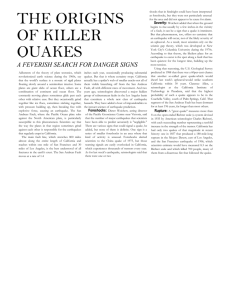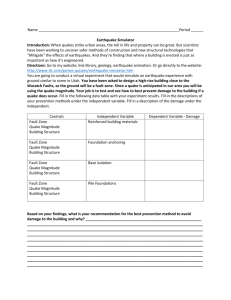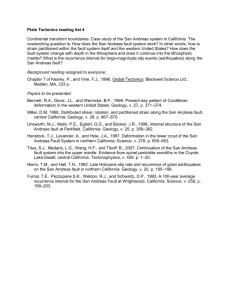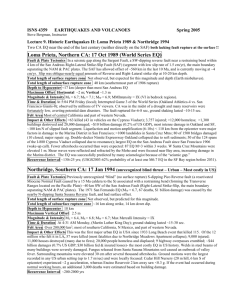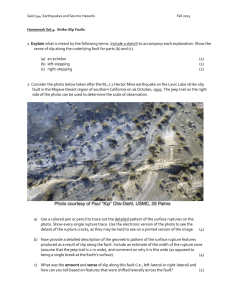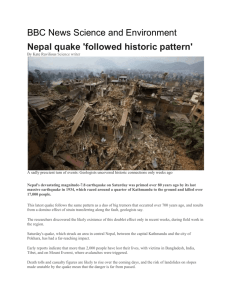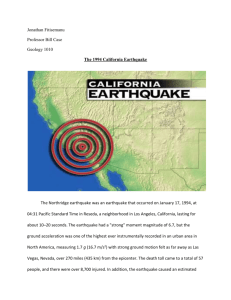When Will the Big One Strike California?
advertisement
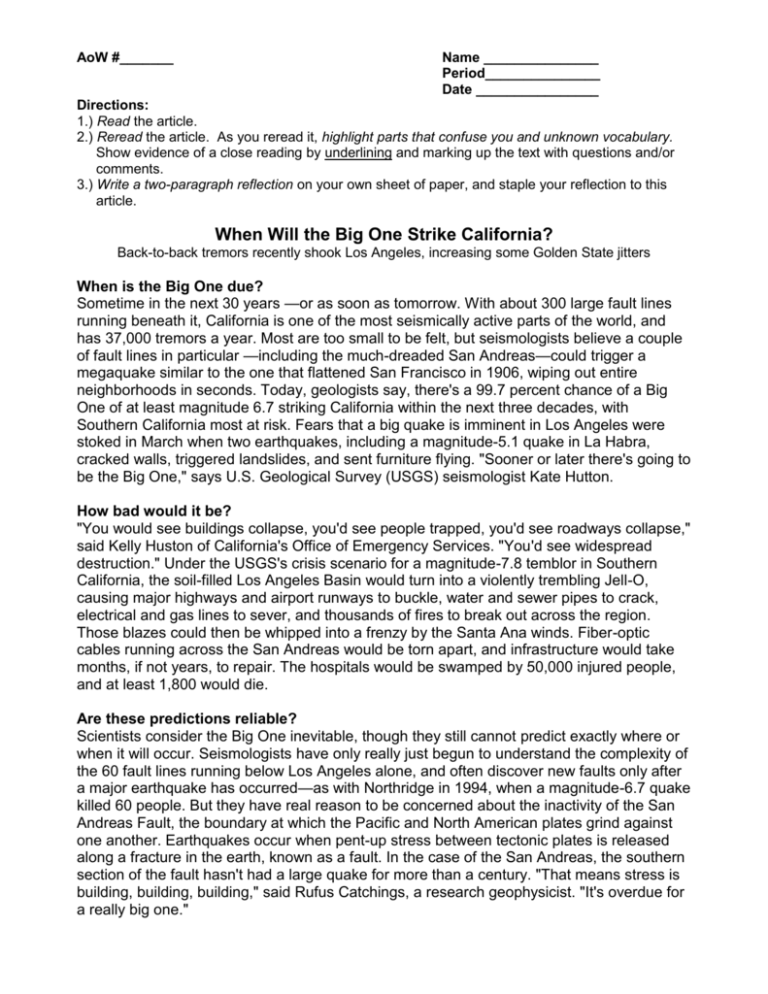
AoW #_______ Name _______________ Period_______________ Date ________________ Directions: 1.) Read the article. 2.) Reread the article. As you reread it, highlight parts that confuse you and unknown vocabulary. Show evidence of a close reading by underlining and marking up the text with questions and/or comments. 3.) Write a two-paragraph reflection on your own sheet of paper, and staple your reflection to this article. When Will the Big One Strike California? Back-to-back tremors recently shook Los Angeles, increasing some Golden State jitters When is the Big One due? Sometime in the next 30 years —or as soon as tomorrow. With about 300 large fault lines running beneath it, California is one of the most seismically active parts of the world, and has 37,000 tremors a year. Most are too small to be felt, but seismologists believe a couple of fault lines in particular —including the much-dreaded San Andreas—could trigger a megaquake similar to the one that flattened San Francisco in 1906, wiping out entire neighborhoods in seconds. Today, geologists say, there's a 99.7 percent chance of a Big One of at least magnitude 6.7 striking California within the next three decades, with Southern California most at risk. Fears that a big quake is imminent in Los Angeles were stoked in March when two earthquakes, including a magnitude-5.1 quake in La Habra, cracked walls, triggered landslides, and sent furniture flying. "Sooner or later there's going to be the Big One," says U.S. Geological Survey (USGS) seismologist Kate Hutton. How bad would it be? "You would see buildings collapse, you'd see people trapped, you'd see roadways collapse," said Kelly Huston of California's Office of Emergency Services. "You'd see widespread destruction." Under the USGS's crisis scenario for a magnitude-7.8 temblor in Southern California, the soil-filled Los Angeles Basin would turn into a violently trembling Jell-O, causing major highways and airport runways to buckle, water and sewer pipes to crack, electrical and gas lines to sever, and thousands of fires to break out across the region. Those blazes could then be whipped into a frenzy by the Santa Ana winds. Fiber-optic cables running across the San Andreas would be torn apart, and infrastructure would take months, if not years, to repair. The hospitals would be swamped by 50,000 injured people, and at least 1,800 would die. Are these predictions reliable? Scientists consider the Big One inevitable, though they still cannot predict exactly where or when it will occur. Seismologists have only really just begun to understand the complexity of the 60 fault lines running below Los Angeles alone, and often discover new faults only after a major earthquake has occurred—as with Northridge in 1994, when a magnitude-6.7 quake killed 60 people. But they have real reason to be concerned about the inactivity of the San Andreas Fault, the boundary at which the Pacific and North American plates grind against one another. Earthquakes occur when pent-up stress between tectonic plates is released along a fracture in the earth, known as a fault. In the case of the San Andreas, the southern section of the fault hasn't had a large quake for more than a century. "That means stress is building, building, building," said Rufus Catchings, a research geophysicist. "It's overdue for a really big one." What about other fault lines? Though seismologists have long dreaded a San Andreas–based quake, experts now fear that a tremor on the Puente Hills fault line could cause as much—if not more —damage. Running from the suburbs of northern Orange County straight through the densest neighborhoods of the Los Angeles Basin, a 7.5 quake on the Puente Hills line would affect millions—including downtown L.A.'s 4 million residents alone—killing up to 18,000 people, causing $250 billion in damage, and leaving as many as 750,000 households homeless, according to the USGS. "This is the fault that could eat L.A.," said USGS seismologist Sue Hough. How has California prepared? Every public building in L.A. has been either retrofitted with steel reinforcements or replaced, and hundreds of state bridges and freeway overpasses have been strengthened. However, about 1,500 concrete buildings across L.A. remain unreinforced and therefore vulnerable—particularly old concrete buildings from the 1950s and '60s. Many owners are reluctant to pay up to $100,000 to have them properly surveyed. In the meantime, officials have advised locals to prepare for the Big One by storing a first aid kit and a two-week supply of emergency food and water, and by keeping an emergency backpack by the door in case they need to leave in a hurry. In theory, officials could install an early warning system that might minimize some of the damage and the death toll, but so far, they haven't. How would that system work? In Japan, hundreds of sensors detect the first pulse of an earthquake and send information about its size and location, giving officials a vital several-second head start on the impending disaster. Trains are automatically stopped to avoid derailment, signs are displayed on highways warning motorists not to head onto bridges, and messages are even sent out to surgeons so that they can remove their scalpels from patients before the shaking begins. In California, a bill creating such a system passed last year, but the state has yet to raise the $80 million needed to properly fund the project. Japan installed its own system only after a killer earthquake raised the political pressure to do so, says USGS seismologist Doug Given. "It's our hope that a bunch of Americans don't have to be killed before we build one." The really Big One If the Big One wasn't scary enough for Californians, scientists have warned that a much greater menace is lurking just offshore in the Pacific Northwest. Running parallel to the West Coast from Northern California to Vancouver Island in Canada, the Cascadia Subduction Zone is an underwater fault that seismologists believe could unleash a mega-thrust earthquake at or above magnitude 9, potentially triggering a huge Pacific tsunami that would destroy Seattle and wash away entire coastal California towns. Tsunami alarms would give some residents about 15 minutes to head to higher shores; the rest, as many as 10,000, would be wiped out by a wall of water —as happened in 1700 when a Cascadia earthquake caused stretches of the Pacific coastline to drop by as much as five feet, triggering a 16-foot wave. Unfortunately, seismologists don't know how often quakes occur on this fault; the next one could be centuries away, or could be already overdue. Possible Topics for your Reflection: Pick and respond to one or more passages in this article Reflect on your family’s emergency preparedness Is building warning systems worth the cost? Explain your answer. .
